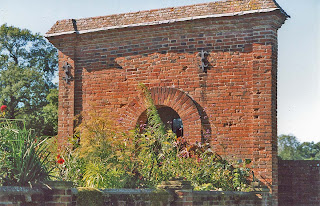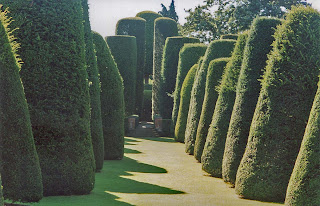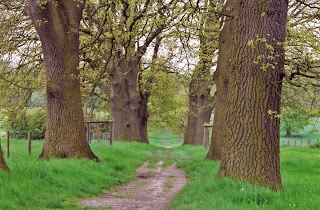Packwood House, in Warwickshire, is a garden with a message. Described by Roy Strong as "capturing the atmosphere of religious emblematic horticulture".
The garden has some conventional herbaceaous borders, and an attractive sunken garden.
Most of these photos were taken at the end of the season and don't do the garden justice. This garden is very near to me, so I will revisit during this season, and get some far better photos.
This photo shows the sunken garden, which looks at its best in the Spring.
This feature is called the Terrace Walk.
You can see that the plants are getting a bit tired and ragged towards the end of the season. The photo enlarges if you want a closer look.
There's a lot of nice brickwork around the garden.
Now we get to the novelties.
The first unusual feature of this garden is a garden of yew trees. The yew garden was originally laid out around 1660.

There is an avenue of yews, and at the far end, another flight of brick steps (just visible in this photo), leading to....
A spiral walkway, which climbs up to a solitary yew.
If you enlarge the photo you can see two figures standing at the top of the walkway, beneath the solitary conical yew.
The entire yew garden is said to represent the Sermon on the Mount. The avenue of yews represents the Apostles, and the single yew is referred to as The Master.
Another novel feature of the garden is a number of clocks and sundials scatered around the garden and on the walls of the buildings. These are just a few...
Like the Yew garden, this collection of time-keeping devices is inviting us to consider something, about time and eternity.
This is a garden which is more than an arrangement of plants. It invites the visitor to engage their minds with the garden and to think about things.
This extract is from The Renaissance Garden in England by Roy Strong:
"What the garden [in general] spoke about most powerfully of all was time. And the object which precipitated these darks thoughts was the sun-dial. Cupid and the Faithful Soul standing within the hortus conclusus point to it. The garden with its cycle of seasons of death and resurrection was a perpetual reminder of life.
One garden which is full of this symbolism and which still survives is Packwood House, Warwickshire. In the absence of any other surviving instance this re-creation seems to capture the atmosphere of this type of religious emblematic horticulture".
The entrance to the property is also unique.
Originally, the approach to the property passed along an avenue of oak trees, a mile long.
The modern road entrance uses a different route, so most visitors today do not normally see the house from this viewpoint.
There is also much to be seen inside the house. These 3 photos are from the guidebook:
The phrase 'A Thinking Man's Garden' is probably worth a post in itself.
On the whole I do think that a man's perception of a garden is different to a woman's. The woman's perception inclines more towards experiencing the garden in terms of senses rather than thought. Though having not been born inside a woman's body I don't know what it's like to experience a garden as woman do. I have to use my feeble brain to think about gardens instead.
















